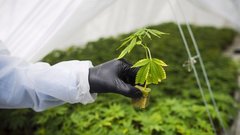Feb 1, 2022
Pot sector nets $15B in taxes, 151k jobs since legalization: Deloitte
Deloitte's cannabis report in focus as industry lobbies Ottawa for regulatory fixes
Despite the layoffs and losses that have plagued most of the country's biggest cannabis companies, Canada's legal pot industry has made a significant economic impact since prohibition ended, according to a new report released Tuesday by Deloitte.
Deloitte said the cannabis sector has generated more than $15 billion in direct and indirect tax revenue for Canadian and provincial governments, while creating more than 151,000 jobs since Canada legalized recreational use of the drug in Oct. 2018.
While Statistics Canada and Health Canada regularly release economic and sales data, the Deloitte report offers the most comprehensive look at how the industry has impacted tax revenue and the labour market since legalization.
All told, Canada's cannabis industry has contributed $43.5 billion to the country's economy between legalization and 2021, Deloitte said. The industry has directly invested roughly $4.4 billion in the economy, while $29.3 billion was sourced from "indirect" economic contributions, and $9.8 billion in "induced" contributions, the report said.

"Our hope with this report is that people would realise that the industry's done a lot more than simply provide [licensed producers] with $4 billion of retail access," said Rishi Malkani, a partner at Deloitte who heads the consultancy's Canadian cannabis practice, in an interview. "It's loaded government coffers and it's been a boon to the construction industry."
Deloitte defines indirect economic contributions by activity generated in other sectors such as construction and manufacturing as a result of the cannabis industry, while induced economic contributions are defined as consumer spending stemming from wages earned from cannabis jobs.
The report noted that indirect economic impacts were modelled to be larger than its direct economic contributions "due to significant capital expenditures on construction and retrofitting-related activities."
Since 2018, Canadians have purchased $11 billion worth of cannabis, while the companies responsible for the production and sale of legal pot have spent $29 billion in capital expenditures during that time, Deloitte said. Of the tax revenue generated, about $1 billion came from direct contributions to government revenue, while another $2.9 billion was sourced from sales and excise taxes. The remaining $11.2 billion was modelled from both indirect and induced tax sources.
Malkani said one of the main data points that leapt out to him was the level of employment the industry has been able to sustain despite the layoffs cannabis companies have conducted as a result of building too much cultivation supply that overshot demand in the Canadian market.
An analysis from trade publication MJBizDaily found that at least 6,000 people employed at 20 Canadian pot producers lost their jobs in 2020.
The report finds that more than 43,479 people are directly employed in the cannabis industry, while another 88,595 people have indirectly found employment due to the legal pot sector. It added that for every million dollars in revenue or capital expenditure, the cannabis sector sustains approximately four jobs in Canada and Ontario.
"We've read so much about the volatility of employment in cannabis," Malkani said. "There was that period in Canada when it seemed like every [licensed producer] was laying people off, which was all taken into account in these numbers."
The report also shed light on the lack of diversity seen in Canada's cannabis industry and re-examined a study by the University of Toronto that found that 72 per cent of executives and directors in the sector identify as caucasian males, while only 16 per cent identify as racialized individuals.
It also highlighted the environmental impact that the cannabis industry bears, with 5,184 kilograms of carbon emissions being expelled into the atmosphere for every kilogram of dried flower produced. As well, between 5.8 million to 6.4 million kilograms of cannabis packaging were sent to landfills from 2018 to 2019 alone, the report said.




